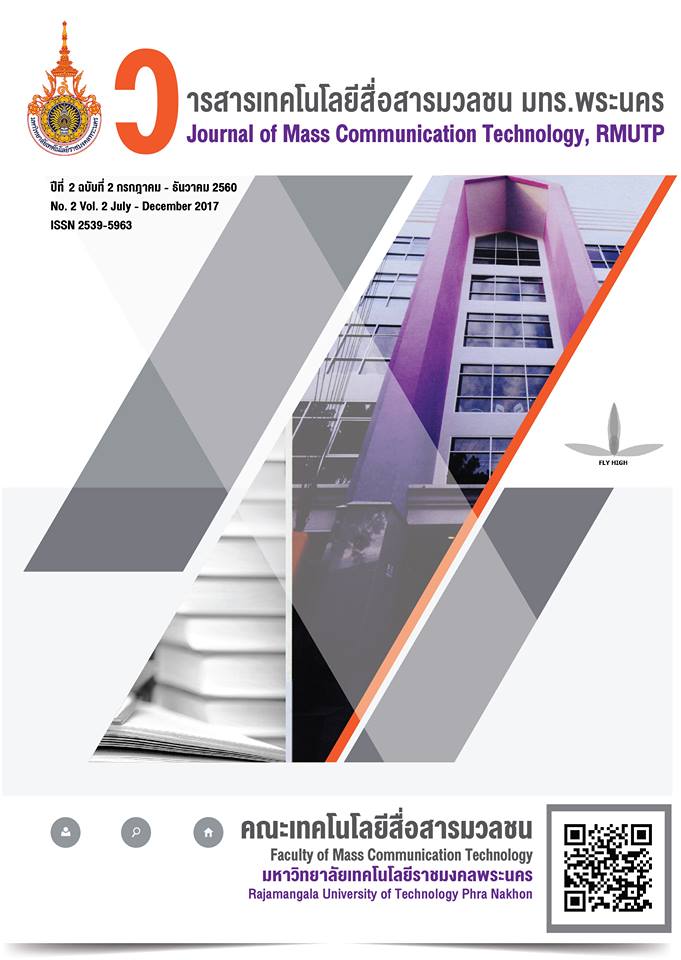แนวทางสู่การเป็นมหาวิทยาลัยอัจฉริยะ ด้วยเทคโนโลยี NFC
คำสำคัญ:
มหาวิทยาลัยอัจฉริยะ, เทคโนโลยีสื่อสารไร้สายระยะใกล้, เทคโนโลยี NFCบทคัดย่อ
การเปลี่ยนแปลงทางเทคโนโลยีอย่างก้าวกระโดดมิได้ส่งผลกระทบเพียงรูปแบบการดำเนินชีวิตของผู้คน ด้วยการเพิ่มทางเลือกในการบริโภคและการอำนวยความสะดวกด้านต่างๆ หากแต่ยังส่งผลกระทบต่อรูปแบบการดำเนินธุรกิจ ขั้นตอนการทำงาน การผลิตและการให้บริการ ตลอดจนสภาพแวดล้อมทางเศรษฐกิจของทุกประเทศ ทำให้การแข่งขันระหว่างประเทศเข้มข้นและรุนแรงมากยิ่งขึ้น ทุกภาคส่วนไม่ว่าจะเป็นภาครัฐ ภาคเอกชนและภาคอุตสาหกรรม รวมถึงภาคการศึกษาจึงจำเป็นต้องเร่งพัฒนาและเพิ่มศักยภาพทางการแข่งขันของตนเองด้วยเทคโนโลยีให้รวดเร็วที่สุด มหาวิทยาลัยจึงจำเป็นต้องเร่งปรับตัวเพื่อตอบสนองความต้องการของทั้งผู้เรียน ผู้สอน และบุคลากร การก้าวสู่การเป็น “มหาวิทยาลัยอัจฉริยะ” (Smart University) ที่มีสภาพแวดล้อมทางเทคโนโลยีที่นักศึกษา ผู้สอน และบุคลากร ตลอดจนสิ่งอำนวยความสะดวกและทรัพยากรต่างๆ ของมหาวิทยาลัย มีปฏิสัมพันธ์กันอย่างเป็นธรรมชาติ โดยอยู่ภายใต้สภาพแวดล้อมยูบิควิตัสคอมพิวติง (Ubiquitous Computing Ecosystem) ที่เชื่อมโยงเครือข่ายกับเทคโนโลยีที่มีอยู่ทำให้เข้าถึงได้ทุกที่ทุกเวลา ซึ่งต้องเพิ่มประสิทธิภาพการมีส่วนร่วมของทั้งนักศึกษา และครูผู้สอน ก่อให้เกิดความร่วมมือกัน และทำให้บรรลุวัตถุประสงค์ในการเรียนรู้ได้ดียิ่งขึ้น ด้วยเทคโนโลยีสื่อสารไร้สายระยะใกล้ (Near Field Communication หรือ NFC) เป็นอีกเทคโนโลยีหนึ่งที่ได้รับความนิยม ดังนั้น มหาวิทยาลัยจึงควรนำมาพิจารณา ศึกษา และประยุกต์ใช้ เพื่อผลักดันสู่การเป็นมหาวิทยาลัยอัจฉริยะต่อไป
เอกสารอ้างอิง
ทีมเศรษฐกิจ (วันที่ 5 พฤษภาคม 2560). “ไขรหัส ประเทศไทย 4.0 สร้างเศรษฐกิจใหม่ ก้าวข้ามกับดักรายได้ปานกลาง.” ไทยรัฐ. สืบค้นจาก http://www.thairath.co.th/content/613903
มนู อรดีดลเชษฐ์. (2560). [ออนไลน์]. Thailand 4.0: Smart Factory Industry 4.0. สืบค้นจาก http://www.thailand40.com/
“ดิจิทัล-มือถือพลิกโลกการเงิน.” (วันที่ 18 มกราคม 2560). กรุงเทพธุรกิจ. 29.
สถาบันเพิ่มผลผลิตแห่งชาติ. (2558). พัฒนาภาคอุตสาหกรรมไทยให้ทันต่อการเปลี่ยนแปลงตามแนวทางการจัดการอนาคต. Future Management. (119), 11-18.
สำนักงานส่งเสริมสังคมแห่งการเรียนรู้และพัฒนาคุณภาพเยาวชน. (2560). [ออนไลน์]. รู้จัก NFC เบื้องหลังมือถือพันธุ์ใหม่แจ้งเกิด. สืบค้นจาก http://www.qlf.or.th/Mobile/Details?contentId=269.
ศักดิ์ เสกขุนทด. (2558). [ออนไลน์]. แนวทางการพัฒนารัฐบาลอิเล็กทรอนิกส์ (e-Government Development) สำนักงานรัฐบาลอิเล็กทรอนิกส์. สืบค้นจาก https://www.ega.or.th/upload/download/
file_54a5f63aec7b34e45700e836f978b1f5.pdf.
ศูนย์บริการการลงทุน สำนักงานคณะกรรมการส่งเสริมการลงทุน สำนักนายกรัฐมนตรี. (2560). [ออนไลน์]. นายกฯ ชูภาคเอกชน นำประเทศสู่ “ประเทศไทย 4.0” “Opportunity Thailand” สร้างโอกาสแห่งอนาคตของไทยและภูมิภาค, สืบค้นจาก http://www.boi.go.th/upload/content/
boi_news_15022017_77195.pdf.
อภิยุกต์ อํานวยกาญจนสิน. (2559). [ออนไลน์]. ขีดแข่งขัน WEF 2016 ประเทศไทย มีอะไรที่ผู้ประกอบการควรรู้. สํานักวิจัยเศรษฐกิจอุตสาหกรรม สืบค้นจาก http://www.oie.go.th/sites/default/files/
attachments/article/capabilities_wef2016.pdf.
Aikinson, R. (2556). [Online]. Competitiveness, Innovation and Productivity: Clearing Up the Confusion. Available from http://www2.itif.org/2013-competitiveness-innovation-productivity-clearing-up-confusion.pdf.
Allpress, M. (2016). [Online]. How does an Enterprise become a Smart Enterprise? Linkedin.
Available from https://www.linkedin.com/pulse/how-does-enterprise-become-smart-matt-allpress.
Brand Buffet. (2017). [ออนไลน์]. สถิติน่ารู้ Digital Movement ทั่วโลก ปี 2017. สืบค้นจาก https://www.brandbuffet.in.th/2017/02/digital-overview-global-stat-2017/.
Bueno-Delgado, M.V., Pavon-Marino, P. & De-Gea-Garcia, A. (2012).”The Smart University experience : A NFC-based ubiquitous environment”, 2012 Sixth International Conference on Innovative Mobile and Internet Services in Ubiquitous Computing, 799-804.
Coccoli, M., Guercio, A. & Maresca, P. (2014). “Smarter Universities: A vision for the last changing digital era.” Journal of Visual Languages and Computing, 25 (2014), 1003-1011
Digital Age. (2017). [ออนไลน์]. เทรนด์แอพฯ Android เพื่อสร้างสรรค์ในปี 2017. สืบค้นจาก https://www.digitalagemag.com/เทรนด์แอพฯ-android-เพื่อสร้างสรรค์ในปี-2017/.
Ernst & Young. (2012). [Online]. University of the Future. A thousand year old industry on the cusp of profound change. Available from http://www.ey.com/Publication/vwLUAssets/
University_of_the_future/%24FILE/University_of_the_future_2012.pdf.
Howart, R. (2013). “Smart Government Key Initiative Overview.” Gartner. Available from https://www.gartner.com/doc/2520516/smart-government-key-initiative-overview.
Investopedia (n.d.). [Online]. Enterprise Mobility. Available from http://www.investopedia.com/
terms/e/enterprise-mobility.asp#ixzz4g0cKE4Xx.
Kantar Millward Brown. (2017). [Online]. AdReaction: Move over, Gen Z is here. Retrieved on 1 June 2017 from http://www.millwardbrown.com/adreaction/genxyz/global/gen-x-y-and-z/the-generations.
Jain, G. & Dahiya, S. (2015). NFC: “Advantage, Limits and Future Scope.” International Journal on Cybernetics & Informatics (IJCI). Vol. 4, No. 4, August 2015.
Kemp, S. (2017). [Online]. Digital in 2017 – Global Overview. We are social, Singapore. Available from https://www.slideshare.net/wearesocialsg/digital-in-2017-global-overview.
Lonsdale, J. (2013). [Online]. The Smart Enterprise Wave. Formation 8. Available from http://www.formation8.com/downloads/TheSmartEnterpriseWave.pdf.
Lutfi, A., Saidi, F., & Watfa, M. (2016). “A Ubiquitous Smart Educational System: Paving the way for Big Educational Data.” The Sixth International Conference on Innovative Computing Technology (INTECH2016).
Lydon, B. (2016). “Industry 4.0: Intelligent and flexible production. Digitization improves manufacturing responsiveness, quality and efficiency.” InTech Magazine, May-June 2016. ISA Publication. Retrieved on 3 May 2017.
Marr, B. (2016). [Online]. What Everyone Must Know About Industry 4.0. Available from https://www.forbes.com/sites/bernardmarr/2016/06/20/what-everyone-must-know-about-industry-4-0/#6b61d91b795f.
NEC. (n.d.). [Online]. Empowering the Smart Enterprise. Cultivating an environment prime for competitive efficiencies. Available from https://www.necam.com/smartenterprise/.
NFC-Forum. (2015). [Online]. Major Retail Study: Mobile Consumers Prefer NFC Technology over Competing Alternatives. Available from http://nfc-forum.org/newsroom/major-retail-study-mobile-consumers-prefer-nfc-technology-competing-alternatives/.
McCrindle. (2015). [Online]. Gen Z and Gen Alpha Infographic Update - CHARACTERISTICS OF THE EMERGING GENERATIONS. Available from http://mccrindle.com.au/the-mccrindle-blog/gen-z-and-gen-alpha-infographic-update.
Oxford College of Marketing Blog. (2016). [Online]. Digital Disruption: What Is It and How Does It Impact Businesses?. Available from http://blog.oxfordcollegeofmarketing.com/
2016/02/22/what-is-digital-disruption/.
PwC. (2013). [Online]. Enterprise mobility putting people first. Aegis Graham Bell Awards 2013. 25 October 2013. Available from https://www.pwc.in/assets/pdfs/.../2013/
enterprise-mobility-putting-people-first.pdf.
PwC. (2015). [Online]. The 2018 Digital University, Staying relevant in the digital age, Talking Points. Available from www.pwc.co.uk/publicsector.
Saparkhojayev N., et al. (2014). NFC-enabled Access Control and Management System. IEEE 2014.
The World Bank Group. (2015). [Online]. Innovation & Entrepreneurship. Available from http://www.worldbank.org/en/topic/competitiveness/brief/innovation-entrepreneurship.
Universities Canada. (2015). Canadian Universities and Our Digital Future – A Workshop by Universities Canada. Retrieved on 20 April 2017.
Wang X., et al. (2015). NFC Mobile Intelligence Campus Construction of Nanjing University of Finance and Economics. 2015 International Conference on Behavioral, Economics, and Socio-Cultural Computing (BESC 2015).
ดาวน์โหลด
เผยแพร่แล้ว
รูปแบบการอ้างอิง
ฉบับ
ประเภทบทความ
สัญญาอนุญาต
Copyright (c) วารสารเทคโนโลยีสื่อสารมวลชน มทร.พระนคร
วารสารเทคโนโลยีสื่อสารมวลชน มทร.พระนคร อยู่ภายใต้การอนุญาต Creative Commons Attribution-NonCommercial-NoDerivatives 4.0 International License. (CC BY-Nc-ND 4.0) เว้นแต่จะระบุไว้เป็นอย่างอื่น โปรดอ่านหน้านโยบายของเราสำหรับข้อมูลเพิ่มเติมเกี่ยวกับการเข้าถึงแบบปิด ลิขสิทธิ์ และการอนุญาต




